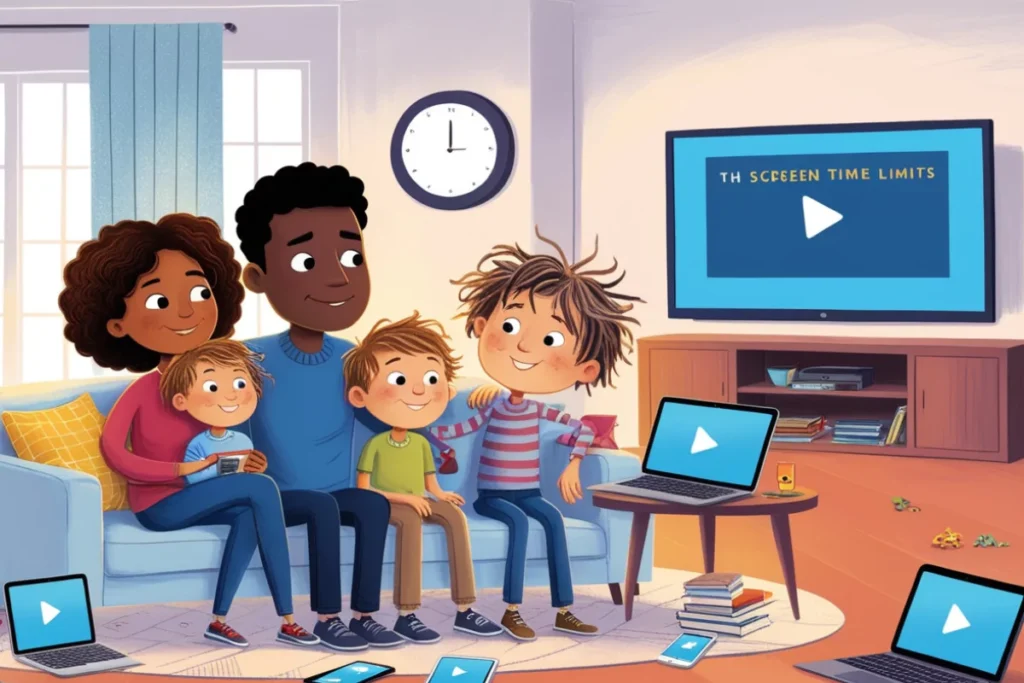Hello, Beautiful People! Want to have balance in your kid’s life? You’ve landed on the right page. Today, I’ll guide you and you’ll see that you can also create a healthy digital lifestyle and reduce screen time.
We all have developed unconsciously the habit of using our phones, just wasting our precious time and scrolling reels. But this causes problems for both our mind and body.
In this blog post, I’m going to share seven simple tips for you. These tips will help you set a healthy screen time so you can live a more balanced digital life.
If you follow these tips, you can enjoy using technology while enjoying family time. Let’s get started!
Table of Contents
Understanding the Need for Screen Time Limits

Following are the tips for a Healthier Digital Lifestyle:
|
Tip Number |
Tips For Screen Time Balance |
|
Tip #1 |
Set Clear Boundaries |
|
Tip #2 |
Create Screen-Free Zones |
|
Tip #3 |
Encourage Physical Activity |
|
Tip #4 |
Promote Social Interaction |
|
Tip #5 |
Prioritize Educational and Productive Screen Use |
|
Tip #6 |
Practice Mindful Screen Use |
|
Tip #7 |
Lead by Example |
Tip #1 – Set Clear Boundaries

Let us start with tip number one which is to set clear boundaries. I’ll explain the ways how you can do this but before that, this is the best way to create a healthy balance between your digital and offline activities. First of all decide some rules for screen use, including:
- During meals
- In the bedroom
- An hour before bedtime.
This will help you focus on your important activities like sleep and family time. I’ll recommend you create a daily or weekly schedule and designate times for screen use. For example, allow screen time only after homework is done or during some time in the evening.
This will keep your screen time under control. Set the same rules and schedule for every member of the house. Be consistent and follow the rules you established.
Tip #2 – Create Screen-Free Zones
The second tip is creating screen-free zones. This means that you have to specify areas in your home where phones are not allowed, including
- Bedrooms (Sleeping area)
- Dining rooms (Family meals and conversation area)
- Kitchen (Eating area).
Clearly communicate with everyone and make sure everyone understands the set rules. You should adopt the behavior you want from your children and reduce screen time. You should adopt activities that promote relaxation, such as books, board games, and crafts.
Tip #3 – Encourage Physical Activity
The third tip is encouraging physical activity. This will promote your overall health. Try to aim for at least 30 minutes of physical activity each day. This should be the activity that everyone enjoys, including:
- Walking
- Biking
- Playing sports
- Dancing
- Hiking
- Playing hide-and-seek
- Any other form of exercise.
It is important to take regular breaks if you are using thee screen for long time to move around. A good rule is the 20-20-20 rule:
- After using the phone for 20 minutes
- Take a 20-second break
- Look at something 20 feet away.
You can download fitness apps and online exercise classes to make physical activity more engaging. If you participate in physical activity, your children will follow you too.
Tip #4 – Promote Social Interaction
The fourth tip is promoting social interaction. This is face-to-face social interaction that builds strong relationships and develops social skills. You can invite your friends and relatives over for meals or gatherings.
This will help your children learn to interact and communicate with others. You can also find opportunities to meet new people such as participation in:
- Local events
- Sports teams
- Clubs
- Community classes.
If your children are school-going, you can promote participation in group projects and extracurricular activities. This also promotes teamwork and communication. Make sure that everyone in the house focuses on interacting with each other.
Some practices your children can adopt include:
- Practice active listening
- Making eye contact
- Taking turns speaking
- Role-playing different social scenarios.
The following video explains about Promote Social Interaction:
Tip #5 – Prioritize Educational and Productive Screen Use
In today’s digital era, screens are an essential part of our lives. While it’s easy to get lost in the endless entertainment options available, you can prioritize educational screen time. You can have knowledge about:
- Online courses
- Documentaries
- Informative articles
By committing screen time to learning new skills and exploring different subjects, we can turn free time into an chance for personal growth.
Moreover, the diversity of educational apps available makes it easier to carry on learning process. When we choose to involve with educational content, we stay mentally and intellectually curious. This use of screen time transforms digital interactions to meaningful involvement.
Tip #6 – Practice Mindful Screen Use
One of the most effective ways to cheer mindful screen use in children is by setting clear boundaries. You should promote educational content. Also, assign specific screen time limits for different activities, such as:
- Learning
- Entertainment
- Communication.
Consistent rules help children understand that how to balance screen time with other important activities. Make screen time both enjoyable and beneficial.
High-quality digital resources can increase learning make screen time an important part of a child’s day. Always make sure that children’s screen time put up positively to their knowledge.
Tip #7 – Lead by Example
Children learn a lot by observing the actions of the grown-ups around them. Parents should set a unique, example for their kids. You should show them the importance of balance and responsible use of technology.
If children see their parents prioritizing live interactions over screen time, they will also adopt similar behaviors. Leading by example means being mindful of your own screen use. Show your children that you shouldn’t let devices control your life.
For example, during family meals, put away your phone and focus on meaningful relations. This will not only strengthen family bonds but also teaches kids that there are places where screens should not be the main focus.
Conclusion
In conclusion, I want to remind you that small changes make big differences. Start making these changes today. You can also have the balance in your life. Trust yourself and make your life the way you want to live.
Implement the above tips today and make your life healthy by maintaining balance with your screens. You’ll start feeling productive and this will impact your whole family.
Best of luck!
FAQ
1. Why should I set screen time limits?
Setting screen time limits has many benefits, including:
- Prevent mental health issues
- Encourages a balanced lifestyle
- Includes physical activity
- Promote social interaction
- Other offline activities.
2. How can my family involved in more physical activity?
You should choose activities that everyone enjoys like:
- Family walks
- Bike rides
- Indoor exercise sessions.
3. What are the signs of excessive screen time?
Some signs of excessive screen time include:
- Constant tiredness
- Difficult sleeping
- Decreased physical activity
- Irritability
- Decline in academic performance.
4. I want to set a good example for my kids, what should I do?
You should follow the same screen time rules you set for your kids. Show your kids how to balance their screen use with other activities.
5. Is 7 hours of screen time healthy?
This isn’t healthy but it can be okay for adults. It only if balanced with breaks and physical activity. Remember that it is too much for kids. Always ensure that screen time doesn’t interfere with:
- Sleep
- Exercise
- Other healthy habits.




